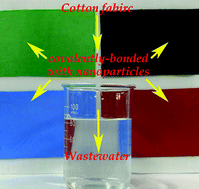A promising clean way to textile colouration: cotton fabric covalently-bonded with carbon black, cobalt blue, cobalt green, and iron oxide red nanoparticles†
Abstract
Textile dyeing industries using conventional small molecular weight organic dyes generate large quantities of refractory wastewater every day, which causes serious problems to the environment. Here, a promising clean method for textile colouration without using organic dyes is reported, which consists of two parts: 1, a darkness control system based on immobilizing functionalized carbon black nanoparticles onto cotton fabric via radiation-initiated co-graft polymerization with vinyl monomers; 2, an approximate RGB (red, green and blue) colour control system by immobilizing cobalt blue, cobalt green, iron oxide red nanoparticles onto cotton fabric that can colourate the cotton fabric with not only the three primary RGB colours but also a series of different colours by blending the three-primary RGB colours. The colour of the cotton fabric can be controlled precisely by changing the degree of grafting of the nanoparticles. The strong covalent bonds network between the nanoparticles and the cotton fabric prevents the release of nanoparticles during usage and the colour remains intact even after intense laundering, equivalent to 100 domestic laundering cycles. The wastewater when using this novel dyeing method is significantly cleaner than the real dyeing industry wastewater and can be discharged without further treatment, taking into consideration directives defined by China and other major textile-producing countries.



 Please wait while we load your content...
Please wait while we load your content...